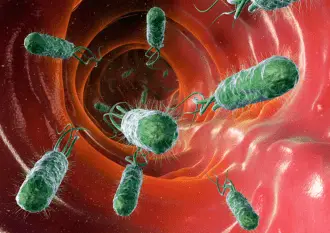Guest writer for Wake Up World
Bacteria, viruses, fungi, parasites — there are many types of harmful organisms and nearly everyone is affected at some point in their life.[1] Different types of harmful organisms affect the body differently. In this article, we’ll look at harmful organisms that affect well-being by targeting and disrupting gut health.
This is a good time to mention that you probably shouldn’t eat while reading this article. Just trust me…
What Are Harmful Organisms?
Harmful organisms are organisms that live off another organism by living on or in them. Essentially, the harmful organism takes up residence in the host organism. In this relationship, harmful organisms steal nutrients and release waste to negatively affect the overall health of the host organism. Harmful organisms are present everywhere, from developing nations to those considered first-world, and have plagued humans since the beginning of time; references even appear in some of our oldest written records.[2, 3]
What Is “The Gut?”
The human digestive tract is a complex system comprised of many parts that, together, function as a single unit. Organs, enzymes, bacteria (commonly referred to as the gut microbiota), and other components collectively make up what we know as “the gut.” In many ways, it is a model ecosystem.
One truth I’ve observed again and again is that gut health is closely tied to overall health. When your gut is vibrant, so are you. When it’s not, neither are you. In fact, when gut function is disrupted, every part of the body is negatively affected. It’s a reality that makes gut-targeting harmful organisms especially devastating.[4]
Which Harmful Organisms Affect the Gut?
The gut is home to many organisms. Most, like probiotics, are absolutely essential to your health; others are detrimental. The two most common organisms that prey on the gut are protozoa and helminth worms.
Protozoa are microscopic, one-celled organisms and there are about 70 species that can affect humans.[2] Some protozoa can form protective “shells” called cysts that allow them to lay dormant for years before striking. Cysts even enable protozoa to survive externally, which means they can transfer and infect new hosts.[5]
Helminth worms are a bigger threat in terms of both species (nearly 300 types can affect humans) and size (adult helminths range in size from under a millimeter to over a meter in length).[6] That’s not a misprint—over a meter, in your body.
Until recently, it was believed that there are two major varieties of helminth worms—roundworms (nematodes) and flatworms (platyhelminths). Flatworms include tapeworms (cestodes) and flukes (trematodes).[7, 8] Researchers have also discovered an entirely new type of helminth called ropeworms.[9] Ropeworms can grow to a meter long and have a lumpy, rope-like shape. They are often mistaken for feces or mucus and go undetected.
For a more detailed discussion of the organisms that can harm your health, please read my article: Health Effects of Harmful Organisms
How Do Harmful Organisms Affect Gut Health?
Protozoa are aggressive, attack quickly, and multiply rapidly.[10,11] Protozoa have the capability to be overwhelming and, in the worst situations, deadly.[7] Symptoms vary by species of protozoa but typically include diarrhea and stomach troubles.
Conversely, worms live long and grow slowly. They attach to the intestinal lining or burrow deep into tissue. There, they steal nutrients and cause intestinal obstruction, often producing chronic, gradually worsening health conditions.[6] In children, worms can affect normal development of the body and brain.[7] Unlike protozoa, worms do not multiply within the human body.
How to Avoid Harmful Organisms
Harmful organisms are transmitted through fecal contamination of food or water and by person-to-person contact.[10,12] If your system is overtaken by protozoa, the problem will be apparent. Worms, however, can live inside the human gastrointestinal tract for years without causing symptoms. When symptoms do appear, they tend to surface in the form of digestive issues.
Proactive measures are the best defense against all types of harmful organisms. Strategies to avoid harmful organisms include:
- Wash your hands with soap and water before handling food or eating.
- Thoroughly wash fruits and vegetables before eating.
- Be cautious about the origin of your food (especially prepared foods).
- I advocate a vegan raw-food diet but if you consume meat, cook it thoroughly and appropriately.
- If you grow your own produce, use safe, organic methods of pest control.
- Protect yourself from environments that accommodate harmful organisms. For example, don’t walk barefoot through puddles.
- If you have indoor pets, limit their outdoor time and groom them regularly.
- Regularly cleanse your living environment.
- Taking a high quality probiotic supplement on a regular basis will help to populate your digestive system with needed, beneficial flora.
- Perform a harmful organism cleanse to assist in removing harmful invaders. It will take at least 6 weeks (the average life cycle of most harmful organisms) to complete a thorough cleanse.
Have harmful organisms negatively affected your life? Please leave a comment below and share your experience with us, or join the conversation on Facebook.
Article references:
- “Parasites and Foodborne Illness.” United States Department of Agriculture Food Safety and Inspection Service. USDA.gov, 7 Aug. 2013. Web. 06 June 2016.
- Cox, F. E. G. “History of Human Parasitology.” Clinical Microbiology Reviews15.4 (2002): 595–612. PMC. Web. 6 June 2016.
- ZACCONE, P et al. “Parasitic Worms and Inflammatory Diseases.” Parasite Immunology 28.10 (2006): 515–523. PMC. Web. 7 June 2016.
- ”Intestinal Parasites.” University of Maryland Medical Center. University of Maryland, 8 Apr. 2014. Web. 07 June 2016.
- Yaeger RG. Protozoa: Structure, Classification, Growth, and Development. In: Baron S, editor. Medical Microbiology. 4th edition. Galveston (TX): University of Texas Medical Branch at Galveston; 1996. Chapter 77.
- Wakelin D. Helminths: Pathogenesis and Defenses. In: Baron S, editor. “Medical Microbiology. 4th edition.” Galveston (TX): University of Texas Medical Branch at Galveston; 1996. Chapter 87
- “Helminth Parasites.” PARA-SITE. The Australian Society for Parasitology, n.d. Web. 07 June 2016.
- Haque, Rashidul. “Human Intestinal Parasites.” Journal of Health, Population, and Nutrition 25.4 (2007): 387–391. Web.
- Volinsky, Alex A., et al. “Development stages of the” rope” human intestinal parasite.” arXiv preprint arXiv:1301.2845 (2013).
- “About Parasites.” Centers for Disease Control and Prevention. Centers for Disease Control and Prevention, 05 Mar. 2014. Web. 07 June 2016.
- “Protozoan Parasites.” PARA-SITE. The Australian Society for Parasitology, n.d. Web. 07 June 2016.
- Lee, Marilyn B. “Everyday and exotic foodborne parasites” The Canadian Journal of Infectious Diseases 11.3 (2000): 155–158. Web.
About the author:
 Dr. Edward F. Group III (DC, ND, DACBN, DCBCN, DABFM) founded Global Healing Center in 1998 and is currently the Chief Executive Officer. Heading up the research and development team, Dr. Group assumes a hands-on approach in producing new and advanced degenerative disease products and information.
Dr. Edward F. Group III (DC, ND, DACBN, DCBCN, DABFM) founded Global Healing Center in 1998 and is currently the Chief Executive Officer. Heading up the research and development team, Dr. Group assumes a hands-on approach in producing new and advanced degenerative disease products and information.
Dr. Group has studied natural healing methods for over 20 years and now teaches individuals and practitioners all around the world. He no longer sees patients but solely concentrates on spreading the word of health and wellness to the global community. Under his leadership, Global Healing Center, Inc. has earned recognition as one of the largest alternative, natural and organic health resources on the internet.
For more information, please visit Global Healing Center.
Recommended articles by Dr. Edward Group:
- The Benefits of Apple Cider Vinegar
- The 9 Best Fermented Foods for Your Gut
- 14 Foods that Cleanse the Liver
- Top 5 Foods for the Pineal Gland
- 6 Things You Must Know About Colloidal Silver
- The Importance of a Kidney Cleansing Diet
- The 9 Best Herbs for Lung Cleansing and Respiratory Support
- 7 Best Foods to Support Kidney Function
- Lung Cleansing With Peppermint Oil
- How Fluoride Damages Pineal Gland Health
- The Top 20 GMO Foods and Ingredients to Avoid – and Why
- How Does the Alkaline Diet Affect Gut Health?
- 15 Best Essential Oils and Their Health Benefits

If you've ever found value in our articles, we'd greatly appreciate your support by purchasing Mindful Meditation Techniques for Kids - A Practical Guide for Adults to Empower Kids with the Gift of Inner Peace and Resilience for Life.
In the spirit of mindfulness, we encourage you to choose the paperback version. Delve into its pages away from screen glare and notifications, allowing yourself to fully immerse in the transformative practices within. The physical book enriches the learning process and serves as a tangible commitment to mindfulness, easily shared among family and friends.
Over the past few years, Wake Up World has faced significant online censorship, impacting our financial ability to stay online. Instead of soliciting donations, we're exploring win-win solutions with our readers to remain financially viable. Moving into book publishing, we hope to secure ongoing funds to continue our mission. With over 8,500 articles published in the past 13 years, we are committed to keeping our content free and accessible to everyone, without resorting to a paywall.







